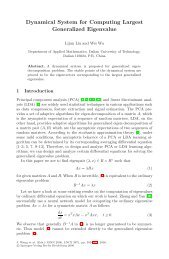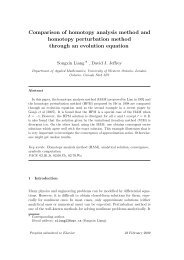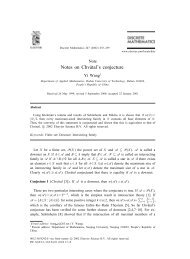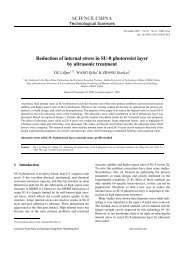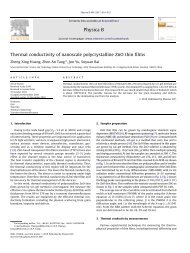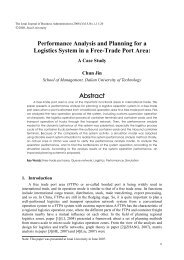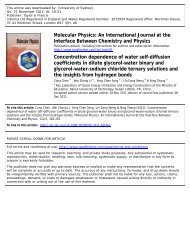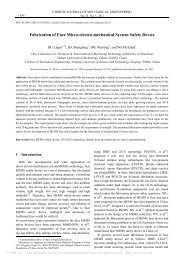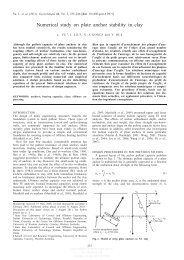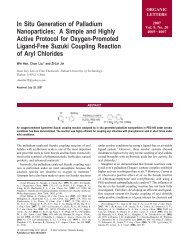A two-fluid model of turbulent two-phase flow for simulating turbulent ...
A two-fluid model of turbulent two-phase flow for simulating turbulent ...
A two-fluid model of turbulent two-phase flow for simulating turbulent ...
Create successful ePaper yourself
Turn your PDF publications into a flip-book with our unique Google optimized e-Paper software.
Ocean Engineering 30 (2003) 153–161<br />
www.elsevier.com/locate/oceaneng<br />
A <strong>two</strong>-<strong>fluid</strong> <strong>model</strong> <strong>of</strong> <strong>turbulent</strong> <strong>two</strong>-<strong>phase</strong> <strong>flow</strong><br />
<strong>for</strong> <strong>simulating</strong> <strong>turbulent</strong> stratified <strong>flow</strong>s<br />
Y.M. Shen a,∗ , C.-O. Ng b , A.T. Chwang b<br />
a<br />
State Key Laboratory <strong>of</strong> Coastal and Offshore Engineering, Dalian University <strong>of</strong> Technology, Dalian<br />
116023, People’s Republic <strong>of</strong> China<br />
b<br />
Department <strong>of</strong> Mechanical Engineering, The University <strong>of</strong> Hong Kong, Pokfulam Road, Hong Kong,<br />
People’s Republic <strong>of</strong> China<br />
Received 7 July 2001; received in revised <strong>for</strong>m 28 November 2001; accepted 31 January 2002<br />
Abstract<br />
In this paper, a <strong>two</strong>-<strong>fluid</strong> <strong>model</strong> <strong>of</strong> <strong>turbulent</strong> <strong>two</strong>-<strong>phase</strong> <strong>flow</strong> is used to simulate <strong>turbulent</strong><br />
stratified <strong>flow</strong>s. This is a unified multi-<strong>fluid</strong> <strong>model</strong> <strong>for</strong> the motion <strong>of</strong> each <strong>phase</strong> in the <strong>flow</strong>,<br />
whose <strong>turbulent</strong> transport is closed by a <strong>two</strong>-<strong>phase</strong> k–e <strong>model</strong>. The exchanges <strong>of</strong> mass, momentum<br />
and energy between the <strong>two</strong> <strong>phase</strong>s are fully accounted <strong>for</strong> in the simulation. For illustration,<br />
a case <strong>of</strong> <strong>turbulent</strong> stratified <strong>flow</strong> with strong buoyancy effects, <strong>for</strong> which extensive<br />
experimental data are available, is selected <strong>for</strong> examination. It is shown that the numerical<br />
results agree well with the experimental data. © 2002 Elsevier Science Ltd. All rights reserved.<br />
Keywords: Buoyancy effects; Stratified <strong>flow</strong>; Two-<strong>phase</strong> turbulence; Two-<strong>fluid</strong> <strong>model</strong><br />
1. Introduction<br />
Complex stratified <strong>flow</strong>s abound in natural and engineering processes. In problems<br />
pertinent to coastal and ocean engineering, environmental pollution, and many other<br />
fields <strong>of</strong> engineering, there <strong>of</strong>ten exist <strong>flow</strong>s with a non-uni<strong>for</strong>m distribution <strong>of</strong> density<br />
or temperature, which in some cases may even have a sharp gradient <strong>of</strong> change.<br />
Such an abrupt spatial change <strong>of</strong> a variable <strong>of</strong>ten makes the problem not amenable<br />
to simple mathematical analyses. Predictive turbulence <strong>model</strong>s <strong>for</strong> the environmental<br />
<strong>flow</strong> and transport have recently been presented by Ni (1996) and Shen et al. (2002).<br />
∗<br />
Corresponding author. Fax: +86-411-4708526.<br />
E-mail address: ymshen@dlut.edu.cn (Y.M. Shen).<br />
0029-8018/02/$ - see front matter © 2002 Elsevier Science Ltd. All rights reserved.<br />
PII: S 00 29 -8018(02)00020-3
154 Y.M. Shen et al. / Ocean Engineering 30 (2003) 153–161<br />
Nomenclature<br />
C 1<br />
C 2<br />
C m<br />
F<br />
g<br />
k<br />
K f<br />
K m<br />
P<br />
R<br />
t<br />
U<br />
X<br />
e<br />
m<br />
m e<br />
m t<br />
ρ<br />
s k<br />
s e<br />
s <br />
<br />
a turbulence coefficient constant<br />
a turbulence coefficient constant<br />
a turbulence coefficient constant<br />
time-averaged frictional <strong>for</strong>ce<br />
gravitational acceleration<br />
<strong>turbulent</strong> kinetic energy<br />
an empirical constant<br />
an empirical constant<br />
time-averaged pressure<br />
a generic variable<br />
time<br />
time-averaged velocity<br />
Cartesian coordinate<br />
<strong>turbulent</strong> kinetic energy dissipation rate<br />
dynamic viscosity<br />
effective dynamic viscosity<br />
dynamic eddy viscosity<br />
substance density<br />
a turbulence coefficient constant<br />
a turbulence coefficient constant<br />
a turbulence coefficient constant<br />
time-averaged volume fraction<br />
Subscripts<br />
1 first <strong>phase</strong><br />
2 second <strong>phase</strong><br />
i component in the i direction<br />
k <strong>phase</strong> k<br />
l <strong>phase</strong> l<br />
r ambient <strong>fluid</strong><br />
rel relative value<br />
These <strong>model</strong>s have made some success. However they do not account <strong>for</strong> the mixing<br />
structure <strong>of</strong> a <strong>flow</strong> field in sufficiently fine detail. A problem that is characterized<br />
by appreciable <strong>phase</strong> exchanges <strong>of</strong> mass, momentum and energy can be too complicated<br />
to be accurately simulated by a simple turbulence closure <strong>model</strong>. It is <strong>of</strong> practical<br />
importance if a <strong>model</strong> is able to distinguish the various components <strong>of</strong> a <strong>flow</strong><br />
field in the course <strong>of</strong> simulation. Spalding (1984) proposed a <strong>two</strong>-<strong>fluid</strong> <strong>model</strong> <strong>of</strong>
Y.M. Shen et al. / Ocean Engineering 30 (2003) 153–161<br />
155<br />
turbulence (see also Markatos, 1985), which was later improved by Fan (1988). A<br />
distinct feature <strong>of</strong> the <strong>model</strong> is to treat a general <strong>phase</strong> as a substance that can be<br />
distinguished by a property parameter such as temperature, pressure, velocity, density,<br />
and so on. Based on the framework <strong>of</strong> the <strong>two</strong>-<strong>fluid</strong> <strong>model</strong>, it is the intention<br />
<strong>of</strong> this work to present a <strong>two</strong>-<strong>fluid</strong> <strong>model</strong> <strong>of</strong> <strong>turbulent</strong> <strong>two</strong>-<strong>phase</strong> <strong>flow</strong> <strong>for</strong> the simulation<br />
<strong>of</strong> <strong>turbulent</strong> stratified <strong>flow</strong>s. Computational results are shown to agree well<br />
with some published experimental data.<br />
2. Physical concepts<br />
A central part <strong>of</strong> the <strong>two</strong>-<strong>fluid</strong> <strong>model</strong> <strong>of</strong> <strong>turbulent</strong> <strong>two</strong>-<strong>phase</strong> <strong>flow</strong> is to consider<br />
such <strong>flow</strong> being composed <strong>of</strong> the interacting <strong>turbulent</strong> motions <strong>of</strong> <strong>two</strong> <strong>fluid</strong>s, which<br />
coexist in time and space but possess different volume fractions. These <strong>two</strong> <strong>fluid</strong>s<br />
in <strong>turbulent</strong> motion can be regarded as interpenetrating continua, which obey their<br />
own governing differential equations. The <strong>two</strong> <strong>fluid</strong>s can have exchanges <strong>of</strong> mass,<br />
momentum and energy with each other. For identification, each <strong>fluid</strong> carries a distinct<br />
phasal mark that remains invariant throughout the <strong>flow</strong>. Let k 1 and k 2be<br />
used to mark the <strong>two</strong> different <strong>fluid</strong>s in the <strong>flow</strong>. Then the related properties <strong>of</strong> such<br />
a<strong>two</strong>-<strong>fluid</strong> <strong>model</strong> can be expressed in the following sections.<br />
2.1. Mixture parameters <strong>of</strong> <strong>two</strong>-<strong>phase</strong> <strong>flow</strong><br />
Any parameter <strong>for</strong> a mixture <strong>of</strong> <strong>two</strong> <strong>phase</strong>s can be obtained by taking a weighted<br />
average <strong>of</strong> the corresponding parameters <strong>for</strong> each <strong>phase</strong>. The volume-average and<br />
mass-average are the <strong>two</strong> typical ways <strong>of</strong> deriving the parameters <strong>of</strong> the mixture,<br />
which are defined as follows:<br />
Volume-average:<br />
R 1 R 1 2 R 2 (1)<br />
Mass-average:<br />
R ( 1 r 1 R 1 2 r 2 R 2 )/r (2)<br />
r 1 r 1 2 r 2 (3)<br />
where 1 and 2 are respectively the volume fractions <strong>of</strong> the first and second <strong>phase</strong>s,<br />
r 1 and r 2 are the respective substance densities <strong>of</strong> the <strong>two</strong> <strong>phase</strong>s, and R is a generic<br />
variable that can be the velocity, turbulence properties, and so on.<br />
2.2. Pressure <strong>of</strong> <strong>two</strong>-<strong>phase</strong> <strong>flow</strong><br />
There are <strong>two</strong> alternative ways <strong>of</strong> defining the mixture pressure <strong>of</strong> <strong>two</strong>-<strong>phase</strong> <strong>flow</strong>.<br />
By the first definition, the mixture pressure is assumed to be composed <strong>of</strong> partial<br />
pressures due to individual <strong>phase</strong>s. It is further assumed that the partial pressure <strong>of</strong><br />
a <strong>phase</strong> amounts to the total pressure multiplied by the <strong>phase</strong> volume fraction k .
156 Y.M. Shen et al. / Ocean Engineering 30 (2003) 153–161<br />
This concept is parallel to that <strong>of</strong> a gas mixture. The <strong>phase</strong> pressure P k and the total<br />
pressure P are there<strong>for</strong>e related by:<br />
P k<br />
P k (P k P k ) (4)<br />
Alternatively, the same pressure is assumed <strong>for</strong> each <strong>phase</strong> and the mixture, i.e.<br />
P k (k 1,2) P. The phasal pressure gradient in the momentum equation is, however,<br />
the pressure gradient weighted by the volume fraction. These <strong>two</strong> ways <strong>of</strong><br />
defining the mixture pressure are related to each other if the contribution to the<br />
pressure gradient is expressed as:<br />
d Pi a P P ∂ k ∂P<br />
<br />
∂X<br />
k (5)<br />
i ∂X i<br />
When a P 1, d Pi ∂(P k )/∂X i ∂P k /∂X i , which is the <strong>for</strong>mer way. When<br />
a P 0, then d Pi k ∂P/∂X i , which corresponds to the latter way. For convenience,<br />
the second way <strong>of</strong> defining the mixture pressure is adopted in this paper,<br />
i.e. a P 0.<br />
3. Mathematical <strong>model</strong><br />
On applying the Reynolds decomposition and averaging to the instantaneous Navier–Stokes<br />
equations, while <strong>model</strong>ing the correlation terms with a gradient-flux closure,<br />
we obtain the governing equations that describe the transport <strong>of</strong> averaged parameters<br />
in a <strong>turbulent</strong> <strong>two</strong>-<strong>phase</strong> <strong>flow</strong> system.<br />
The time-averaged continuity equation (volume fraction equation) <strong>for</strong> <strong>phase</strong> k is<br />
∂<br />
∂t (r k k ) ∂ (r<br />
∂X k k U kj ) ∂<br />
j<br />
∂X j l<br />
s k<br />
k<br />
m el<br />
m ek<br />
The time-averaged momentum equation <strong>for</strong> <strong>phase</strong> k is<br />
s l ∂ k<br />
∂X j S k,l m k,l (6)<br />
∂<br />
∂t (r k k U ki ) ∂<br />
∂X j<br />
(r k k U kj U ki ) ∂<br />
∂X j m ek<br />
s kU kj<br />
∂ k<br />
∂X i<br />
U ki<br />
∂ k<br />
∂X j (7)<br />
∂<br />
∂X j k m ek ∂U ki<br />
∂X j<br />
∂U kj<br />
∂X i k<br />
∂R<br />
∂X i<br />
k (r k r r )g i F ki<br />
The transport equation <strong>of</strong> <strong>turbulent</strong> kinetic energy <strong>for</strong> <strong>phase</strong> k is<br />
∂<br />
∂t (r k k k k ) ∂<br />
∂X j<br />
(r k k U kj k k ) ∂<br />
∂X j m ek<br />
s kk<br />
k<br />
∂k k<br />
∂X j ∂<br />
∂X j m ek<br />
s k<br />
k k<br />
∂ k<br />
∂X j (8)<br />
r k k e k G k B k a f m ek∂U ki<br />
m el∂U li<br />
s Uk ∂X i s Ul ∂X i
Y.M. Shen et al. / Ocean Engineering 30 (2003) 153–161<br />
157<br />
The transport equation <strong>of</strong> <strong>turbulent</strong> kinetic energy dissipation rate <strong>for</strong> <strong>phase</strong> k is<br />
where<br />
∂<br />
∂t (r k k e k ) ∂<br />
∂X j<br />
(r k k U kj e k ) ∂<br />
∂X j m ek<br />
s ek<br />
k<br />
∂e k<br />
∂X j ∂<br />
∂X j m ek<br />
s k<br />
e k<br />
∂ k<br />
∂X j (9)<br />
e k<br />
k k<br />
(C 1 G k C 2 r k k e k )2a f re k<br />
F ki K f r k l |U ki U li |(U ki U li )e/k 1.5 (10)<br />
S k,l E K m r k l |U ki U li |e/k 1.5 (11)<br />
m k,l m el<br />
s l<br />
m ek<br />
s k ∂ k<br />
∂ l<br />
(12)<br />
∂X j ∂X j<br />
G k ∂U ki<br />
∂X j m ek<br />
s k<br />
U kj<br />
∂ k<br />
∂X i<br />
m ek k ∂U ki<br />
∂X j<br />
∂U kj<br />
∂X i (13)<br />
B k m ek<br />
s k r kr r<br />
∂ k<br />
g<br />
∂X i (14)<br />
i<br />
r k<br />
a f 1 r K fE (15)<br />
k 2 k<br />
m tk r k C m<br />
e k<br />
(16)<br />
m ek m k m tk (17)<br />
In the equations presented above, the symbols have the following meanings: t is<br />
time; subscripts k and l are the <strong>fluid</strong> marks which may be either 1 or 2 (but k l);<br />
F ki is the component <strong>of</strong> the time-averaged frictional <strong>for</strong>ce <strong>of</strong> <strong>phase</strong> k in the i direction;<br />
U ki and U li are the components <strong>of</strong> the time-averaged velocity <strong>of</strong> <strong>phase</strong>s k and l in<br />
the i direction, respectively; k and l are the time-averaged volume fractions <strong>of</strong><br />
<strong>phase</strong>s k and l, respectively; r, k and e are the density, <strong>turbulent</strong> kinetic energy and<br />
<strong>turbulent</strong> kinetic energy dissipation rate <strong>of</strong> mixture, respectively; P is the time-averaged<br />
pressure <strong>of</strong> the mixture; m k , m tk and m ek are the dynamic viscosity, dynamic<br />
eddy viscosity and effective dynamic viscosity <strong>of</strong> <strong>phase</strong> k, respectively; r k is the<br />
substance density <strong>of</strong> <strong>phase</strong> k; r r is the substance density <strong>of</strong> ambient <strong>fluid</strong>; s k is the<br />
<strong>turbulent</strong> Schmidt number <strong>of</strong> <strong>phase</strong> k (which is constant in general, but strongly<br />
influenced by buoyancy effects that can be accounted <strong>for</strong> with the Munk–Anderson<br />
empirical <strong>for</strong>mula, Rodi, 1993); g i is the component <strong>of</strong> gravitational acceleration in<br />
the i direction; K f , K m , s kk , s ek , C 1 , C 2 and C m are all empirical constants <strong>for</strong> which<br />
the following values are chosen: K f 0.05, K m 0.1, s kk 1.0, s ek <br />
1.3, C 1 1.44, C 2 1.92 and C m 0.09.
158 Y.M. Shen et al. / Ocean Engineering 30 (2003) 153–161<br />
4. Numerical computation and discussion on results<br />
A<strong>two</strong>-<strong>fluid</strong> <strong>model</strong> system is obviously much more complex to compute than a<br />
one-<strong>fluid</strong> system. For one thing, the number <strong>of</strong> differential equations <strong>for</strong> a <strong>two</strong>-<strong>fluid</strong><br />
<strong>model</strong> is twice that <strong>for</strong> a one-<strong>fluid</strong> <strong>model</strong>. Also, the non-linearity and coupling <strong>of</strong><br />
the equations are much stronger owing to interactions between the <strong>two</strong> <strong>fluid</strong>s. The<br />
equations are coupled not only within those <strong>for</strong> the same <strong>phase</strong>, but also among<br />
those <strong>for</strong> different <strong>phase</strong>s. On the other hand, the solution to the coupled equations<br />
is highly sensitive to the initial values. Numerical efficiency is also strongly affected<br />
by the methods <strong>for</strong> discretization and iteration, and the way <strong>of</strong> relaxation. These<br />
computational difficulties can be mitigated only through taking good care <strong>of</strong> the nonlinearity<br />
and coupling. In this regard, the numerical method that approaches the <strong>two</strong><strong>fluid</strong><br />
system from a no-slip one-<strong>fluid</strong> system is used.<br />
A unified multi-<strong>fluid</strong> <strong>model</strong> is adopted here, and the <strong>two</strong>-<strong>phase</strong> <strong>flow</strong> can be computed<br />
by finite differences in a unified Eulerian field. In this work, the second-order<br />
implicit SIMPLE scheme is extended to the <strong>two</strong>-<strong>phase</strong> <strong>flow</strong>. The pressure correction<br />
equations are obtainable from the continuity equation <strong>for</strong> the mixture. By treating a<br />
<strong>two</strong>-<strong>fluid</strong> system from the approach <strong>of</strong> a no-slip one-<strong>fluid</strong> system, the <strong>two</strong>-<strong>phase</strong><br />
coupling system is numerically solved with an under-relaxation iterative scheme.<br />
4.1. Numerical example<br />
The <strong>two</strong>-<strong>fluid</strong> <strong>model</strong> described above is applied to a problem as shown in Fig. 1,<br />
<strong>for</strong> which the extensive data available from Uittenbogaard (1988) can be used <strong>for</strong><br />
comparison. In the experiment, a <strong>turbulent</strong> mixing layer was created between <strong>two</strong><br />
streams <strong>of</strong> water, initially separated by a splitter plate, having different velocities<br />
and salinity concentrations. The <strong>two</strong> streams were maintained at a constant (and<br />
equal) temperature but with a density difference <strong>of</strong> 15 kg/m 3 . The denser stream was<br />
below the lighter one, a condition that gives rise to stable stratification leading to<br />
suppression <strong>of</strong> <strong>turbulent</strong> mixing. This <strong>flow</strong> problem was adopted as a test case <strong>for</strong><br />
‘The Fourteenth Meeting <strong>of</strong> the IAHR Working Group on Refined Flow Modelling’<br />
(Scheuerer, 1989).<br />
The boundary conditions at the inlet cross-section, comprising pr<strong>of</strong>iles <strong>of</strong> the<br />
dependent variables, were specified in the experiment, while at the exit the <strong>flow</strong> was<br />
already fully developed. The top was a slip plane (rigid-lid approximation) and the<br />
Fig. 1.<br />
Flow geometry and coordinate system.
Y.M. Shen et al. / Ocean Engineering 30 (2003) 153–161<br />
159<br />
Fig. 2.<br />
Computed and measured pr<strong>of</strong>iles <strong>of</strong> velocity <strong>of</strong> the mixture.<br />
Fig. 3.<br />
Computed pr<strong>of</strong>iles <strong>of</strong> velocities <strong>of</strong> the <strong>two</strong> <strong>fluid</strong>s.<br />
bottom was a smooth wall where the velocity follows a standard log-law and turbulence<br />
is in local equilibrium.<br />
4.2. Computational results and discussion<br />
Comparisons between the computed and the measured pr<strong>of</strong>iles <strong>of</strong> velocity U, <strong>turbulent</strong><br />
kinetic energy k, and relative density r rel (rr 1 )/(r 2 r 1 ) <strong>for</strong> the mixture<br />
are presented in Figs. 2, 4 and 6. The computed pr<strong>of</strong>iles <strong>of</strong> velocity U and <strong>turbulent</strong><br />
kinetic energy k <strong>for</strong> the <strong>two</strong> <strong>fluid</strong>s are shown in Figs. 3 and 5. These pr<strong>of</strong>iles are<br />
located at 5, 10 and 40 m downstream <strong>of</strong> the splitter plate. Clearly, the predictions<br />
<strong>for</strong> the velocity and relative density are in very close agreement with the data in all<br />
stages <strong>of</strong> the <strong>flow</strong> development. It is reproduced in the computation that the initially<br />
Fig. 4.<br />
Computed and measured pr<strong>of</strong>iles <strong>of</strong> <strong>turbulent</strong> kinetic energy <strong>of</strong> the mixture.
160 Y.M. Shen et al. / Ocean Engineering 30 (2003) 153–161<br />
Fig. 5.<br />
Computed pr<strong>of</strong>iles <strong>of</strong> <strong>turbulent</strong> kinetic energy <strong>of</strong> the <strong>two</strong> <strong>fluid</strong>s.<br />
Fig. 6.<br />
Computed and measured pr<strong>of</strong>iles <strong>of</strong> the relative density.<br />
distinct boundary layers that were developed on either side <strong>of</strong> the splitter plate have<br />
almost merged into a single shear layer akin to a boundary layer developing over<br />
the flume’s bed. The predictions also clearly show that the <strong>turbulent</strong> kinetic energy<br />
has completely collapsed in the outer part <strong>of</strong> the shear layer under the influence <strong>of</strong><br />
strong stable stratification.<br />
It is also apparent from the velocity and relative density pr<strong>of</strong>iles that the presence<br />
<strong>of</strong> buoyancy makes the <strong>phase</strong> coupling to be <strong>of</strong> the ‘check type’, i.e. the <strong>phase</strong><br />
coupling does not tend to make the distribution <strong>of</strong> parameters uni<strong>for</strong>m but tends to<br />
make the parameters maintain their own identity. The upper lighter stream <strong>flow</strong>s<br />
<strong>for</strong>ward while attempting to diffuse into the lower layer. On the other hand, the<br />
lower denser stream holds out against the lighter one to restrain it from descending.<br />
The density stratification is hence developed and sustained, although the <strong>turbulent</strong><br />
entrainment between the <strong>two</strong> <strong>phase</strong>s continues to take place. The intensity <strong>of</strong><br />
entrainment decreases with an increase in density difference between the <strong>two</strong><br />
streams. The pr<strong>of</strong>iles <strong>of</strong> the averaged parameters obviously provide a comprehensive<br />
description <strong>of</strong> the complex internal process. There<strong>for</strong>e the <strong>two</strong>-<strong>fluid</strong> <strong>model</strong> can not<br />
only simulate the phenomenal movement <strong>of</strong> a <strong>fluid</strong>, but also reveal fine details <strong>of</strong><br />
the internal processes resulting from the complex movement <strong>of</strong> the <strong>fluid</strong>. This is in<br />
sharp contrast to a one-<strong>fluid</strong> <strong>model</strong>.
Y.M. Shen et al. / Ocean Engineering 30 (2003) 153–161<br />
161<br />
5. Summary and concluding remarks<br />
(a) The <strong>two</strong>-<strong>fluid</strong> <strong>model</strong> <strong>of</strong> <strong>turbulent</strong> <strong>two</strong>-<strong>phase</strong> <strong>flow</strong> is capable <strong>of</strong> not only <strong>simulating</strong><br />
the phenomenal movement <strong>of</strong> a <strong>fluid</strong>, but also revealing details <strong>of</strong> the<br />
internal processes <strong>of</strong> the mixing in a <strong>two</strong>-<strong>phase</strong> <strong>flow</strong>. One-<strong>fluid</strong> <strong>model</strong>s fall<br />
short in doing so.<br />
(b) A <strong>two</strong>-<strong>fluid</strong> <strong>model</strong> has twice the number <strong>of</strong> differential equations as that <strong>for</strong><br />
a one-<strong>fluid</strong> <strong>model</strong>. The interactions between the <strong>two</strong> <strong>fluid</strong>s lead to stronger<br />
non-linearity and the coupling <strong>of</strong> equations. To circumvent these difficulties,<br />
the numerical method that approaches the <strong>two</strong>-<strong>fluid</strong> system from a no-slip one<strong>fluid</strong><br />
system is used.<br />
(c) The SIMPLE numerical procedure is extended to the <strong>two</strong>-<strong>phase</strong> <strong>flow</strong> in this<br />
paper. An iterative under-relaxation method <strong>of</strong> pressure correction <strong>for</strong> solving<br />
the system <strong>of</strong> difference equations <strong>of</strong> the <strong>two</strong>-<strong>fluid</strong> <strong>model</strong> <strong>of</strong> <strong>turbulent</strong> <strong>two</strong><strong>phase</strong><br />
<strong>flow</strong> has been developed.<br />
(d) The <strong>two</strong>-<strong>fluid</strong> <strong>model</strong> <strong>of</strong> <strong>turbulent</strong> <strong>two</strong>-<strong>phase</strong> <strong>flow</strong> has a great potential <strong>for</strong><br />
further development. In particular, the establishment <strong>of</strong> a more rational mathematical<br />
<strong>model</strong> that can correctly relate the exchanges <strong>of</strong> mass, momentum<br />
and energy between <strong>two</strong> <strong>fluid</strong>s is highly desirable.<br />
6. Acknowledgments<br />
This research is sponsored by the Hong Kong SAR Research Grants Council under<br />
Grant No. NSFC/HKU 8, the National Science Fund <strong>for</strong> Distinguished Young Scholars<br />
under Grant No. 50125924, the National Natural Science Foundation <strong>of</strong> China<br />
under Grant No. 49910161985, and the Research Fund <strong>for</strong> the Doctoral program <strong>of</strong><br />
Higher Education under Grant No. 2000014112.<br />
References<br />
Fan, W.C., 1988. A <strong>two</strong>-<strong>fluid</strong> <strong>model</strong> <strong>of</strong> turbulence and its modifications. Science in China (Series A) 31<br />
(1), 79–86.<br />
Markatos, N.C., 1985. Computer simulation techniques <strong>for</strong> <strong>turbulent</strong> <strong>flow</strong>s. Encyclopaedia <strong>of</strong> Fluid Mechanics<br />
6 (1), 1259–1275.<br />
Ni, H.Q., 1996. Current status and development trends <strong>of</strong> turbulence <strong>model</strong>ling. Advances in Mechanics<br />
26 (2), 145–165.<br />
Rodi, W., 1993. Turbulence <strong>model</strong>s and their application in hydraulics, 3rd ed. Balkema, Rotterdam<br />
(IAHR Monograph).<br />
Scheuerer, G., 1989. Compilation <strong>of</strong> results <strong>for</strong> stably stratified mixing layer. In: Proceedings <strong>of</strong> the 14th<br />
Meeting <strong>of</strong> the IAHR Working Group on Refined Flow Modelling, Munich.<br />
Shen, Y.M., Zheng, Y.H., Komatsu, T., Kohashi, N., 2002. A three-dimensional numerical <strong>model</strong> <strong>of</strong><br />
hydrodynamics and water quality in Hakata Bay. Ocean Engineering 29 (4), 461–473.<br />
Spalding, D.B., 1984. Two-<strong>fluid</strong> <strong>model</strong>s <strong>of</strong> turbulence. In: NASA Langley Workshop on Theoretical<br />
Approaches to Turbulence, Hampton (VA).<br />
Uittenbogaard, R.E., 1988, Measurement <strong>of</strong> turbulence fluxes in a steady, stratified mixing layer. In:<br />
Proceedings <strong>of</strong> the Third International Symposium on Refined Flow Modelling and Turbulence<br />
Measurements, Tokyo, Japan, pp. 725–732.



